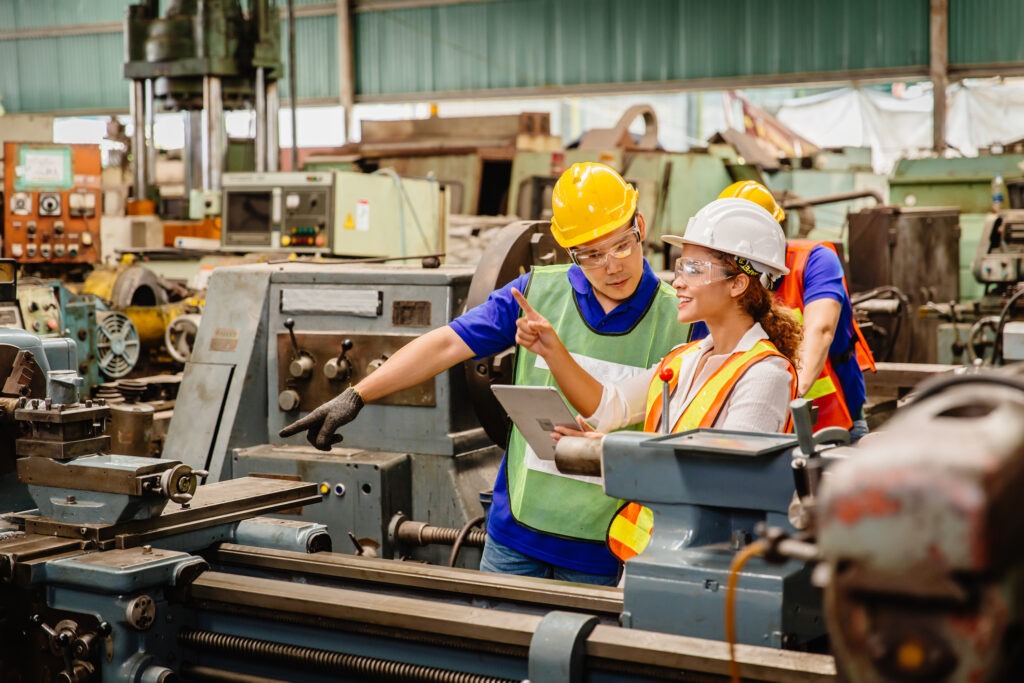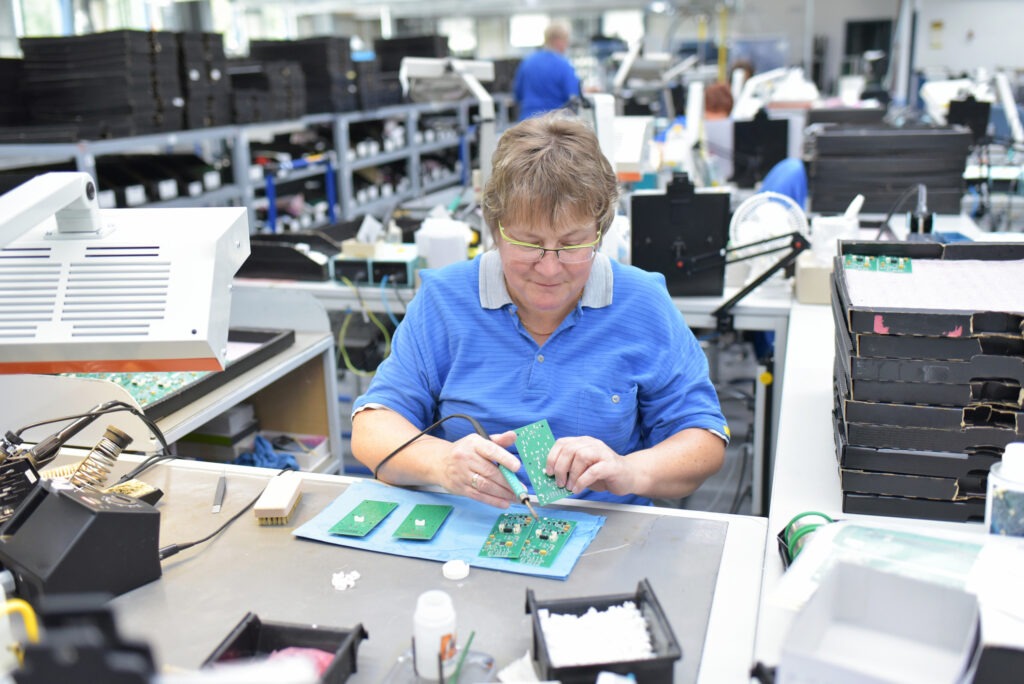What are the general working conditions in production & manufacturing like?
With regard to the working conditions for a particular activity in production, there are various criteria that need to be looked at. This starts with the working hours, continues with the protective clothing and culminates with the overall physical strain.
Table of contents
- What are the general working conditions in production & manufacturing like?
- What are the working hours in production?
- What are the advantages and disadvantages of shift work?
- How does working in a 3-shift or 4-shift system differ?
- What distinguishes piecework from normal production?
- What is the physical strain in production like?
- What measures can companies take to counter this?
Estimated reading time: 14 minutes
What are the working hours in production?
Theoretically, the working hours for employees in production vary depending on the exact occupation and company. However, there are certain general rules that are generally adhered to. For example, the traditional 40-hour working week is often still in place. However, there are also companies where production employees only work 38.5 or even 35 hours per week.
Then there is the nature of the working hours. In addition to the traditional 8 a.m. to 5 p.m., there are also various models with shift work, overtime, and working at weekends or at night. Exactly how work is done depends on the company, the collective agreements, the order situation, and other circumstances. Especially when a company is fully booked, continuous production is ensured around the clock with shift work and overtime.
What are the legal regulations for working hours?
In addition, there are other models that can be used when workloads are low. These include the option of working flexitime. There are certain statutory regulations for working hours as a whole:
- The daily working time: Work may only be performed for a maximum of 8 hours per day. However, it is possible to deviate from this and work up to 10 hours a day under certain conditions.
- The weekly working time: As a rule, an employee may only work 48 hours per week. However, the company can also deviate from this in exceptional cases. Employees may then work up to 60 hours per week. The employer must ensure that the average weekly working time does not exceed 48 hours over a period of 16 calendar weeks.
- The rest periods: The law stipulates sufficient rest periods between work periods. Industrial production is also covered. The companies and trade unions then jointly determine how the regulations are to be structured in detail.
- Breaks: There must be sufficient breaks during working hours. Here, too, it is up to the companies or collective bargaining parties to decide how this is to be organized.
Which flexitime models are practical in industrial production?
Flexitime models are used from time to time. This allows employees to organize their personal working hours flexibly. However, there are certain limits to this. In general, employees are given a choice of two hours in the morning in which to start work. At the end of the agreed working time, they can then leave their workplace again. If a worker works 8 hours plus a 1-hour lunch break and starts at 8 a.m., they finish work at 5 p.m. However, if they only start at 10 a.m., i.e. at the end of the two-hour period, their working day ends at 7 p.m. accordingly.
There is also a so-called core working time for flexitime models. During this time, all employees must be present in the company and carry out their work. In the example above, the core working hours would be 10 a.m. to 5 p.m.

What are the advantages and disadvantages of shift work?
There are a number of advantages and disadvantages to shift work within production, both for employees and for the company. The advantages start with higher utilization of machines and systems. This allows a company to get more work done from an existing stock of production systems without having to expand them, which would involve costs. Instead, the systems are simply operated around the clock. This means that there is no downtime at night, on weekends, or on public holidays. However, the higher costs for the workforce remain and even increase with regard to work at unfavorable times, i.e. at night and on weekends and public holidays. Overall, however, this significantly reduces production costs.
Increasing plant capacity utilization also enables the company to react flexibly to order peaks. Without excessive investment in new production facilities, it can cope with demand by producing around the clock. The employer can flexibly adjust the workload and the number of employees, for example by working overtime, using temporary workers or hiring a contractor.
What problems can be solved by shift work?
Further advantages arise almost as a by-product. For example, a company that works around the clock is also available around the clock. This means that problems from logistics, suppliers, or customers can be tackled immediately without having to wait until the next day.
In addition, it allows work to be carried out in shifts and with a possibly extended core workforce, for example through temporary workers. This leads to increasing specialization of long-term employees. They then act as experts in core areas, while temporary workers and new staff take on the additional work. This increases work efficiency and offers long-term employees their own opportunities for advancement and higher pay. For employees as a whole, shift work offers the prospect of a higher income. Overtime, night shifts, working on weekends or on public holidays all mean higher pay per hour.
What are the disadvantages of shift work in production?
While shift work offers clear advantages for companies, it also brings significant disadvantages for employees. They are under greater psychological strain, as they have to reconcile shift work with their private and family lives. Employees with families in particular face the problem of finding time to be together.
There are also health problems associated with shift work. The body's natural biorhythm is disturbed, especially when switching between day and night shifts. This results in sleep disorders, stomach and intestinal complaints, cardiovascular problems, high blood pressure, and even mental illness.
Social life, which is particularly important in terms of coping with stress, is also under greater strain. The irregular working hours make it more difficult to meet friends and acquaintances or to undertake joint activities.
The risk of suffering from chronic exhaustion or burnout increases as a result of the disruption to the biorhythm, the strain on health, and the strain on family and social life. These health problems are also associated with issues regarding future employment. The affected employee becomes less attractive to future employers because their physical performance is impaired.
How does working in a 3-shift or 4-shift system differ?
A 3-shift or 4-shift system is usually used for shift work. Both allow production to be maintained almost continuously, while offering varying degrees of flexibility.
In the 3-shift system, the production staff work in three shifts per day. These regularly consist of an early shift, a late shift, and a night shift. Each shift lasts 8 hours, resulting in a 24-hour day. The system allows flexibility and round-the-clock work on weekdays. Flexible planning is required for weekends and public holidays.
In the 4-shift system, the workforce is divided into four groups. These consist of an early shift, a late shift, and a night shift. There is then an additional, fourth shift. Depending on the regulations and breaks, a shift can last 8 hours or even 12 hours. The 4 shifts can either rotate or form two groups, which then work as 12-hour shifts in the Panama scheme.
The advantages of the 4-shift system are that operations can be maintained 24/7. Weekends and public holidays no longer cause any interruptions and do not require any special planning or preparation.
Which system is chosen then depends on the circumstances in which the company finds itself. However, if production is always fully continuous, 4-shift systems are more common.

What distinguishes piecework from normal production?
In regular production, the employer sets a fixed monthly wage and allocates a certain number of working hours to it. The employee must offer to work the agreed number of hours. Whether this is then utilized by the company or not is irrelevant for the remuneration. In other words, whether the employee is working to capacity or just drinking coffee, he receives his monthly wage.
In contrast to normal production, the employer calculates the wage for piecework based on the actual amount of work performed. The employer does not set a fixed monthly salary, but agrees on a specific unit of output with the employee, for example a number of pieces, a weight, or another measurable criterion. The employer pays the wage according to this quantity produced.
What form of pay is used for piecework?
Instead of an hourly wage for production employees in normal production, a piecework wage is paid. This also results in a different incentive for work performance. In normal production, good performance means a secure job, a pay rise, and possibly a promotion, which is also linked to a pay rise. In contrast, piecework is all about quantity. The more that is produced, the more money there is.
Normal production combines quality with quantity. Good work requires a sufficient quantity of output, which is also associated with a certain degree of precision. Piecework, on the other hand, is geared more towards speed in order to produce a sufficient quantity to earn a wage. Quality is not unimportant here, but takes a back seat to quantity.
How is piecework organized in shift work?
Piecework is often used in conjunction with shift work. It is particularly suitable for production workers in packaging. Here, wages are calculated according to the number of boxes folded or filled. Assembly workers in electrical assembly or employees in the production of bicycles are also often paid according to quantity. In certain companies, machine operators in the production of cars are paid according to unit output.
Piecework is prohibited by law for pregnant women, young people, and staff who perform driving duties. This is due to the higher health risk for those affected and the increased risk of accidents when driving vehicles. However, this regulation can be waived for young people in training and, under certain conditions, for pregnant women. This is always the case if the company can prove that there are no health risks associated with piecework.
What is the physical strain in production like?
There are a number of different types of stress in production. These are usually of a physical nature, but there are often also psychological aspects that should not be forgotten. It starts with the fact that production employees are on their feet all day long. They lift objects, carry them, and often have to work in awkward postures. In addition, many movements are repeated several times a day. The work is also sometimes associated with vibrations from machines, extreme temperatures, noise, dust, and the wearing of protective clothing, which can make movements even more difficult, impair them, or lead to other stresses.
What kind of mental stress is there in production?
In addition to strains on the muscles, joints, and bones, there is the psychological strain. While this is theoretically not physical, it is nevertheless linked to the physical strain. The pressure to perform, time pressure, and overall long working hours mean that the body's warning signals are ignored. This then leads to a drop in performance, which in turn increases the pressure that the employee is under.
Genuine back pain is a regular consequence of mental stress. Back pain is also caused by physical strain and tension. The latter is often caused by unfavorable postures.
How does an unhealthy environment affect the body at work?
An unhealthy environment, stress due to the pressure, long periods of standing or sitting, and the high physical demands affect the cardiovascular system. The consequences range from varicose veins and high blood pressure to cardiovascular diseases.
Working in a noisy environment with dust, chemicals, and other conditions puts a strain on the airways, ears, and eyes. This then leads to a drop in hearing ability, visual acuity, and a reduction in breathing capacity.
Extreme temperatures, vibrations from machines, and handling tools pose a risk of illness and injury. They reduce well-being and lead to increased stress levels, which can then lead to secondary illnesses.
What influence do high-paced jobs and performance pressure have on the health of production workers?
With regard to quick-paced production work and performance pressure, it is clear that this leads to stress. This in turn leads to fatigue in those affected and increases the risk of burnout.
However, it doesn't have to go that far. The monotony of the work already causes its own problems. It is based on the fact that the same movements are performed over and over again and the same processes take place. This creates a feeling of boredom among the employees concerned, which then leads to gradual dissatisfaction. This in turn is a cause of more errors in production, which not only increases the risk of accidents but also leads to costs for incorrectly performed work.
The noise that employees are sometimes exposed to leads to stress. It also causes concentration problems, which increase the risk of accidents and lead to errors in production. It also causes sleep disturbances, which in turn increase stress and reduce the ability to concentrate.
What measures can companies take to counter this?
However, companies have already recognized these problems and are taking more and more measures to counteract them. This starts with the ergonomic design of workstations, processes and movements. The aim is to reduce the strain on the body.
In addition, structural measures, ventilation, and other improvements are used to reduce exposure to noise and dust. Technical aids such as better tools are used to make the work easier and thus reduce the strain on bones, muscles, and joints.
Regular breaks also help to maintain performance. They break up monotonous movements, allow employees to escape the noisy and dusty environment, and reduce the perceived time and performance pressure. This reduces physical and mental stress at the same time.
As part of training courses, employees are made aware of the requirements for health, accident prevention, and dealing with stress. This makes it easier for them to cope with existing strains. A healthy culture is also promoted in the workplace so that employees can support each other in coping with stress.
Related topics:
